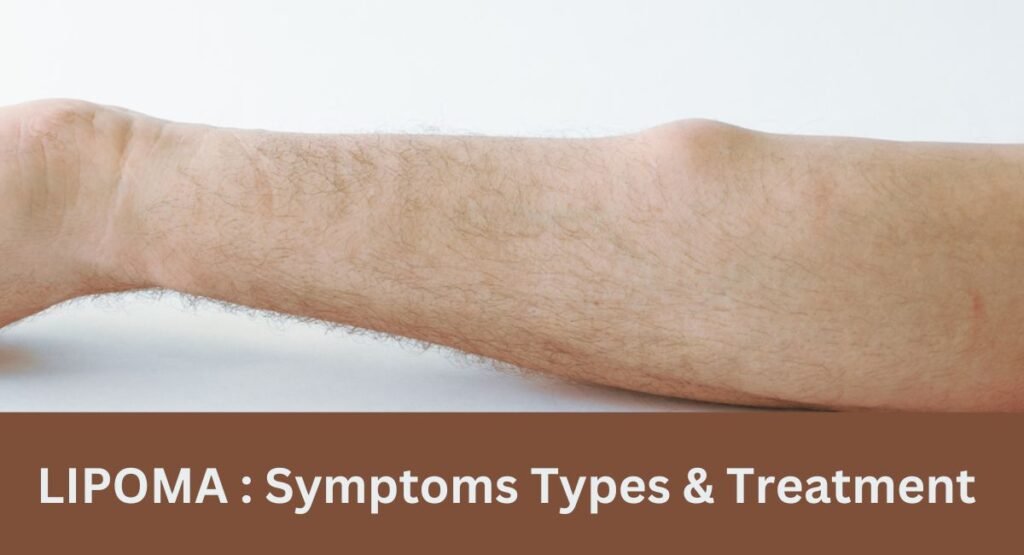Lipoma Treatment in Delhi
Ayurvedic Treatment for Lipoma– According to Ayurveda, the condition known as Medoja granthi can be correlated with lipoma. In this condition, there is an accumulation of vitiated Vata dosha and disturbed medas dhatu (fat tissue) along with Kapha dosha in the muscle tissue (Mamsa) and blood vessels. This leads to the formation of a cystic-like swelling with an excess collection of fat.

Medoja granthi shares similar symptoms with lipoma, such as softness (mrudu), mobility (chala), smooth or ghee-like appearance (shleshma tulya akriti or snigdha), size changes with the growth of the body (deha kshaya vriddhi kshaya), and the possibility of ghee-like discharge when burst open (pindyak sarpi prathimam).
According to Ayurvedic principles, Medoja granthi is considered curable. Ayurvedic treatments aim to balance the doshas, remove the accumulated toxins, and promote the proper functioning of tissues. These treatments may include herbal medicines, panchakarma procedures, dietary adjustments, lifestyle modifications, and rejuvenation therapies to address the underlying imbalances and promote healing.
It is important to consult with an experienced Ayurvedic practitioner for a comprehensive evaluation and personalized treatment plan based on your individual condition.
Types of Lipoma
- Superficial Subcutaneous Lipoma: A common type that forms beneath the skin, usually found on the upper body.
- Deep Subfascial Lipoma: Develops within the fascial layer, deeper beneath the skin, often requiring surgical removal.
- Intramuscular Lipoma: Located within the muscle tissue, these lipomas can cause discomfort and may must surgical intervention.
- Angiolipoma: A lipoma with an increased number of blood vessels, giving it a reddish appearance.
- Spindle Cell Lipoma: Composed of elongated spindle cells, found on the neck, shoulders, and upper back.
- Fibrolipoma: A lipoma characterized by an extra presence of fibrous tissue, resulting in a firmer texture.
- Hibernoma: A rare type of lipoma that contains brown fat, often found in the neck, shoulder, and thigh regions.
- Neural Fibrolipoma: Involves nerve tissue and fatty growth, occurring on the nerves of the wrist and hands.
- Intradermal Spindle Cell Lipoma: A lipoma found within the dermal layer of the skin, usually presenting as a soft, slow-growing lump.
- Multiple Familial Lipomatosis: Characterized by the presence of many lipomas across the body, often in a hereditary pattern.
Signs and symptoms of lipoma
- Soft, rubbery lump: Lipomas typically feel soft and have a rubbery texture when touched.
- Easily movable: They are usually movable and can be pressed or shifted under the skin.
- Slow-growing: Lipomas tend to grow slowly over time, often taking months or years to become noticeable.
- Usually painless: Most of cases, lipomas are painless, although they may cause discomfort if they press against nerves or surrounding tissues.
- Located just below the skin: Lipomas are commonly found just beneath of the skin’s surface, often in areas such as the neck, shoulders, back, or arms.
- Varying sizes: Lipomas can range in size from small pea-sized lumps to larger masses several centimeters in diameter.
Ayurvedic treatment for Lipoma
Ayurvedic treatment for lipoma is a non-surgical approach. In the initial stages, lipomas can be effectively treated with ayurvedic medicines. However, in chronic cases, individuals may require purification procedures known as panchakarma treatments. These procedures aim to eliminate imbalanced doshas and prevent the recurrence of lipomas. Ayurveda focuses on holistic healing and aims to restore overall balance in the body to promote natural healing and wellness. It is advisable to consult with an experienced Ayurvedic practitioner for a personalized treatment plan based on your specific condition.
Lipoma Treatment at non-suppurative stage
In Ayurveda, there are specific treatments mentioned for the management of Medoja granthi or lipoma. Some of these treatments include:
- Dahana with Tapta Loha: This involves cauterization using molten iron. It is believed to help in reducing the size of the lipoma by promoting the absorption of excessive fat tissue.
- Swedana with Darvi or Daruharidra: Swedana refers to fomentation or steaming. In this case, it is done using the bark of Berberis aristata (Darvi) or the herb Daruharidra. It is believed to promote circulation, reduce inflammation, and facilitate the breakdown of accumulated fat in the lipoma.
- Laksha Lepa: Laksha refers to the secretion of an insect species called Laccifer lacca. This secretion is applied topically as a paste or ointment on the lipoma. It is believed to have a reducing effect on the size of the lipoma and promote its absorption.
These Ayurvedic treatments are mentioned in the ancient texts and are intended to address the underlying imbalances and promote the natural healing process. It is important to note that these treatments should be performed by qualified Ayurvedic practitioners who can assess your specific condition and provide personalized care.
Tests advised in lipoma
Lipomas do not require extensive testing for diagnosis. The diagnosis is typically based on a physical examination and medical history. However, in certain situations or if there are concerns about the nature of the lump, a healthcare professional may recommend additional tests. These tests may include:
- Imaging tests: Ultrasound, MRI (Magnetic Resonance Imaging), or CT (Computed Tomography) scan can provide detailed images of the lipoma and surrounding tissues, helping to confirm the diagnosis and rule out other conditions.
- Biopsy: In rare cases, a biopsy may be recommended if there are concerns about the nature of the lump. A small sample of the lipoma tissue is taken and examined under a microscope to determine if any abnormality or malignancy is present.
When to consult with Doctor
Ayurvedic Treatment for Lipoma- If you notice any symptoms or changes that could be indicative of a lipoma, it is advisable to consult with a doctor as soon as possible. While lipomas are generally benign and not a cause for immediate concern, it is important to have them evaluated by a medical professional to ensure an accurate diagnosis and appropriate management.
